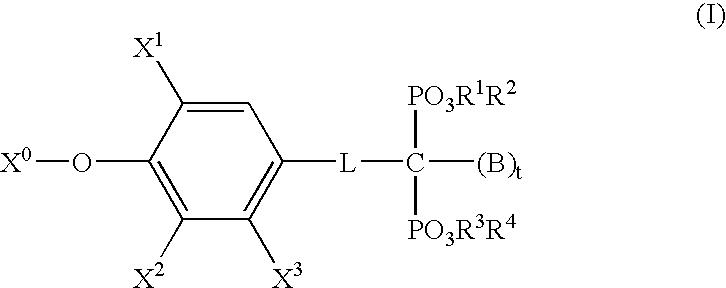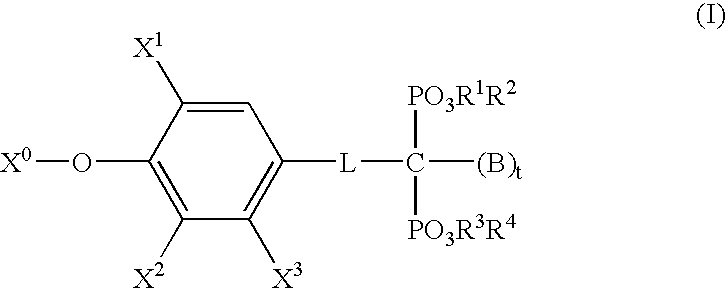Methods of treating skin with diphosphonate derivatives
- Summary
- Abstract
- Description
- Claims
- Application Information
AI Technical Summary
Benefits of technology
Problems solved by technology
Method used
Image
Examples
example 1
Stimulation of Collagen Expression
[0033] HepG2 cells were grown in Dulbecco's modified Eagle medium (DMEM) supplemented with 10% FBS. Cells were harvested when they were about 80-90% confluent and were directly subjected to RNA isolation. Treated cells were incubated with 1 μM Apomine and control cells were incubated with a volume of ethanol used as vehicle for the Apomine.
[0034] DNA microarray slides used in this study were fabricated in the microarray core facilities at the Arizona Cancer Center (Calaluce et al., 2001). Each slide has 5760 spots divided into 4 blocks. Each block contains the same 8 ice plant genes from Mesembryanthemum crystallinum and 23 different housekeeping genes as references for data normalization. Overall, each slide has 5289 unique human cDNA sequences.
[0035] Poly(A)+ RNA was directly isolated from cell pellets using the FastTrack 2.0 Kit (Invitrogen, Carsbad, Calif.) following the instruction manual provided by the manufacturer. Each RNA sample was ins...
example 2
Measurement of Apomine
[0039] Plasma concentrations of Apomine are measured with a Hewlett Packard gas chromatograph using a nitrogen phosphorus detector and HP-5 15 m×0.32 mm column. Alberts et al., 2001). Apomine is extracted from plasma with methyl t-butyl ether (MTBE). To 250 μl of plasma sample, 10 μl of a methanolic solution of the internal standard (n-propyl phoposhonate analog of Apomine) at a final concentration of 4 μg / ml are added and mixed by vortexing. The compound and internal standard are extracted with 500 μl MTBE and 30 sec vigorous shaking. The organic layer obtained by centrifugation (5 min at 13,000 rpm) is dried under nitrogen and reconstituted in 250 μl MTBE of which 2 μl is injected with an autoampler for analysis. A calibration curve is established with plasma from untreated mice spiked with different concentrations of Apomine. The calibration curve is used to interpolate the concentrations of Apomine in the samples using the peak area ratio values.
example 3
Percutaneous Absorption of Apomine
[0040] Apomine (1 mg) was topically applied to five to six week old female Swiss nude (nu / nu) mice by application of 20 μl of a 50 mg / ml solution of Apomine in acetone. Treatment was continued daily for 24 days. Three hours after the last application the mice were sacrificed and plasma Apomine levels were measured. The plasma concentration was 1.12±0.10 μg / ml plasma (n=6), which is 2 μM Apomine. It is to be expected that the local concentration of Apomine achieved in skin will be in excess, and possibly in far excess, of the concentration of Apomine achieved in the plasma. Thus, the skin level will be in excess of the 1 μM concentration of Apomine that resulted in increased collagen expression in Hep2 cells.
PUM
| Property | Measurement | Unit |
|---|---|---|
| Composition | aaaaa | aaaaa |
Abstract
Description
Claims
Application Information
 Login to View More
Login to View More - R&D
- Intellectual Property
- Life Sciences
- Materials
- Tech Scout
- Unparalleled Data Quality
- Higher Quality Content
- 60% Fewer Hallucinations
Browse by: Latest US Patents, China's latest patents, Technical Efficacy Thesaurus, Application Domain, Technology Topic, Popular Technical Reports.
© 2025 PatSnap. All rights reserved.Legal|Privacy policy|Modern Slavery Act Transparency Statement|Sitemap|About US| Contact US: help@patsnap.com



